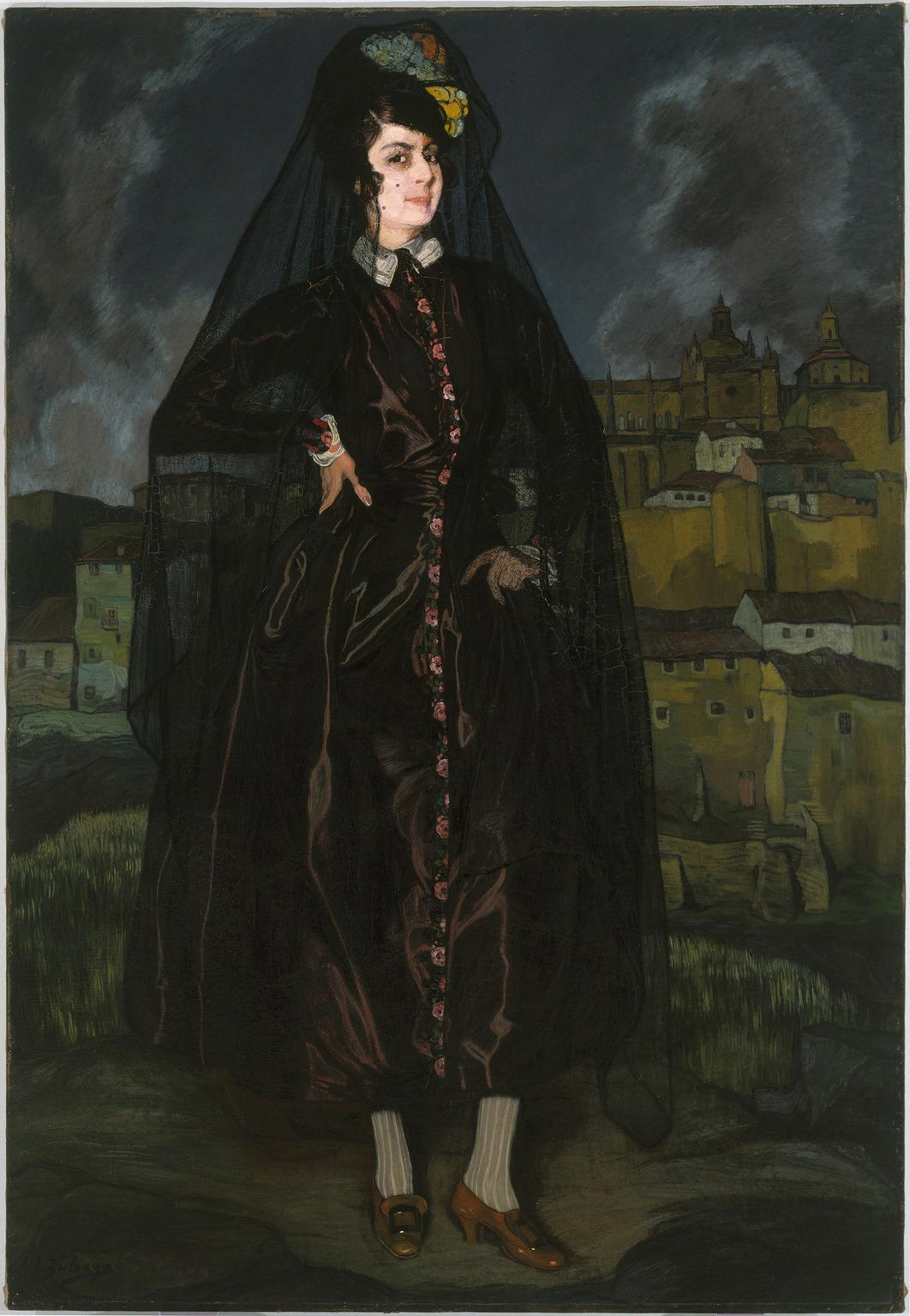Portrait of Anita Ramírez in Black
Ignacio Zuloaga y Zabaleta

Brooklyn Museum photograph
Object Label
Captivated by the vivid nightlife of Parisian cabarets, Ignacio Zuloaga y Zabaleta painted its colorful performers, including the Spanish dancer Anita Ramírez. Zuloaga matched Ramírez’s almost theatrical costuming, featuring a Spanish mantilla, or lace shawl, with her confrontational gaze and cheeky pose. Here, the famous cathedral and ancient city walls of Segovia, Spain, are reduced to a backdrop, a pictorial device the artist often employed.
Caption
Ignacio Zuloaga y Zabaleta (Spanish, 1870–1945). Portrait of Anita Ramírez in Black, 1916. Oil on canvas, 75 1/8 x 51 1/2 in. (190.8 x 130.8 cm) frame: 3 × 80 × 56 in., 77 lb. (7.6 × 203.2 × 142.2 cm, 34.93kg). Brooklyn Museum, Museum Collection Fund, 18.41. (Photo: Brooklyn Museum)
Gallery
Not on view
Gallery
Not on view
Title
Portrait of Anita Ramírez in Black
Date
1916
Geography
Place made: Europe
Medium
Oil on canvas
Classification
Dimensions
75 1/8 x 51 1/2 in. (190.8 x 130.8 cm) frame: 3 × 80 × 56 in., 77 lb. (7.6 × 203.2 × 142.2 cm, 34.93kg)
Signatures
Signed lower left: "I. Zuloaga"
Credit Line
Museum Collection Fund
Accession Number
18.41
Frequent Art Questions
Who was this woman?
This work is a portrait of the Spanish dancer Anita Ramirez. She was one of the artist, Zuloaga's, favorite models at the time this was created. Ramirez and Zuloaga both lived in Paris at the time.Zuloaga used his work to showcase Spanish national pride and focuses on themes such as bullfighters and dancers. Here, Ramirez is shown wearing traditional Spanish clothing and, in the background, is a Gothic cathedral from the city of Segovia.Thank you.Do you know the reason behind putting a Picasso next to this very classic portrait of Anita Ramírez?
 They have more in common than you might think! Each of these women can be seen as an allegory for their time and if you look closely, you’ll notice that they are wearing very similar clothing.Both were also painted in Paris! The portrait of Anita Ramírez in Black captures the spirit of a Spanish cabaret dancer in Paris in 1916. The Picasso, meanwhile, is from 1943, and shows us a much less glamorous, German occupied Paris when Picasso lived there during World War IIThe contrast between these two paintings illustrates the rapid developments and broad variations in Western painting in the first half of the 20th century.
They have more in common than you might think! Each of these women can be seen as an allegory for their time and if you look closely, you’ll notice that they are wearing very similar clothing.Both were also painted in Paris! The portrait of Anita Ramírez in Black captures the spirit of a Spanish cabaret dancer in Paris in 1916. The Picasso, meanwhile, is from 1943, and shows us a much less glamorous, German occupied Paris when Picasso lived there during World War IIThe contrast between these two paintings illustrates the rapid developments and broad variations in Western painting in the first half of the 20th century.Tell me more.
 The dancer Anita Ramírez was one of Zuloaga's favorite models. He was known for painting characteristically Spanish subjects including dancers, bullfighters, peasants, and even some members of the upper-class who commissioned portraits. He even designed his frames, this one is original to the painting.
The dancer Anita Ramírez was one of Zuloaga's favorite models. He was known for painting characteristically Spanish subjects including dancers, bullfighters, peasants, and even some members of the upper-class who commissioned portraits. He even designed his frames, this one is original to the painting.Why do people like portraits?
 Often portraits are used to communicate something about the person who is being painted. You'll notice that many of the portraits nearby, for instance, show wealthy people in very fine clothing, and are meant to communicate their power, wealth, and style.In this case, the artist Ignacio Zuloaga y Zabaleta chose his subject, the dancer Anita Ramírez because he liked to paint her. She is shown in a black veil, or mantilla and against the backdrop of Segovia in Spain. This portrait tells us that she is Spanish, like the artist, even though they were both living in Paris.
Often portraits are used to communicate something about the person who is being painted. You'll notice that many of the portraits nearby, for instance, show wealthy people in very fine clothing, and are meant to communicate their power, wealth, and style.In this case, the artist Ignacio Zuloaga y Zabaleta chose his subject, the dancer Anita Ramírez because he liked to paint her. She is shown in a black veil, or mantilla and against the backdrop of Segovia in Spain. This portrait tells us that she is Spanish, like the artist, even though they were both living in Paris.
Have information?
Have information about an artwork? Contact us at